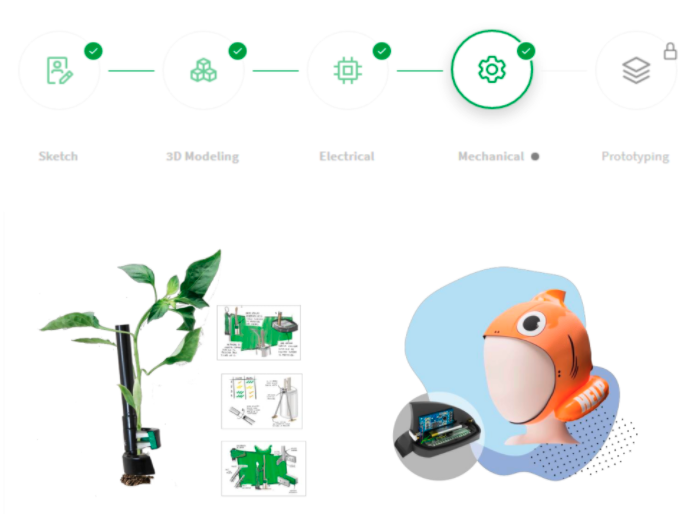Prototyping
A Paradigm Shift in Prototyping: A New Model
Limitations and barriers such as the ability, expertise, and skills of a small team have a major impact on the products that succeed in going from idea stage to being a functional prototype. Inventors in some cases find that slow timelines mean they missed the opportunity to be first to market, some are priced out of taking their ideas any further, and others end up with a product that doesn’t do what they had foreseen. What this ultimately means though, is that good ideas aren’t being executed well enough or as required and inventors are missing out on opportunities. A remedy to this has been needed for some time.
Technology has helped create a new model – one that is already disrupting the more traditional options. This new digital approach places automation at its heart to accelerate design and prototyping, while enabling inventors to retain control and executive decision-making power.
The new model uses a digital platform to enable inventors to share their ideas with a diverse field of expert industrial design and engineering professionals from around the world and have those experts compete for the project. But instead of bidding via quotes, in the way a consultancy might win a project put out to tender by a company, experts win the project by showing how they would complete the task/activity that they are competing for.
This means the priority is placed on making the best possible prototype, instead of inventors comparing quotes which inevitably don’t include the hidden costs traditional methods add on at the later stages.
The process is then repeated for every stage of the prototyping. At every phase, inventors are selecting the expert that has proven they are most aligned with the idea and how they would execute. And this is within closely controlled package costs, which means inventors know how much they’ll be paying and need not worry about escalating budgets.
Being a digital platform, inventors can oversee and progress their projects remotely from anywhere in the world, in real-time, and aren’t limited by geographical accessibility to consultancies, industrial design and engineering teams or freelancers.

This graphic below shows the step-by-step process of LastBasic. Here, the five stages flow from sketching, 3D modelling, electrical engineering, mechanical engineering, and finally to prototyping.

A growing number of inventors are already turning their ideas into reality with the new digital, automated approach. The Smart Shoot Remover and Delfiup (see above) are real-world examples of this successful process in action.
The Benefits of This New Model
The traditional methods for prototyping summarised above have not adapted to the opportunities that technology present – they operate much the same way as they have done for years and there is little evidence that this is changing. The new model embraces technology to eliminate many of the barriers that exist in the traditional models.
So, for starters, by automating much of the process, the inefficiencies and delays caused by manual input and administration are eliminated. Inventors are no longer at the mercy of account managers holding back progress, because the timeline is dictated by the automated system. Inventors and expert designers and engineers have set timelines, which ensures consistency across projects and user experiences. With LastBasic, for example, the timeline is complete in only 3-4 months, which is considerably faster than is possible through the traditional methods on the market.
Critically, the new model pools talent, experience, knowledge, skills, and problem solving from designers and engineers from around the world. This means proposals for how to prototype ideas are more varied than, say, a consultancy, where thinking is limited by internal rules and politics, a lack of geographical diversity, and many other factors.
Also, because the proposals are submitted by designers and engineers as part of a competition with other engineers in the community, there is a constant need for proposals to be of the highest quality – engineers are inspired and incentivised to deliver their best work. They also have the opportunity to review the work of their competition, which encourages post-project knowledge sharing and constant development.
Importantly for some, control and decision making remains in the hands of inventors. They decide which proposals to proceed with and can provide feedback if alterations are needed, while outsourcing the activities themselves to proven experts with decades of prototyping experience. In LastBasic’s case, the inventor also retains 100% of the legal rights to their idea and prototype.
The controlled costs is another reason why the new model is taking off. Because of the package-based funding and a single fixed payment, inventors know ahead of time the costs of making their prototyping. This ensures no hidden costs further down the line that could create budgetary issues. It is, on the whole, a more open and transparent process than the traditional models. It is also much more affordable than traditional options because technology has enabled much of the process to be automated.

Thanks to the greater visibility, cost benefits, elimination of inefficiency, this new model is being heralded as the democratisation of prototyping. Many of the old barriers to turning an idea into a product – such as high cost, the need for knowledge and experience, and the potential for loss of control – are completely removed, enabling anyone in the world with an idea and motivation to turn their idea into a reality. This is, undoubtedly, a major paradigm shift in prototyping that has the potential to accelerate innovation across any sector and anywhere in the world.

Getting your invention made is more affordable than ever
Our sharing economy model makes us very competitive with prices being up to 80% lower than others.
View Pricing
Getting started couldn't be easier
All you have to do is;
Select your package, complete and submit your idea brief for validation, make the payment and begin your onboarding through to a working prototype.
It's that simple!